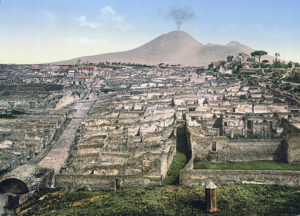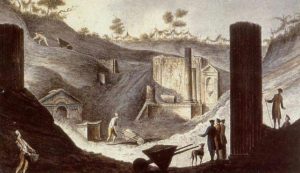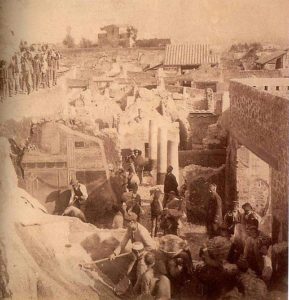
The above postcard image, circa 1900, is of the archeological dig at Pompeii, Italy. The city remained completely buried in ash for approximately 1,500 years, after an eruption in 79 A.D., of Mount Vesuvius, which is seen in the background. Pompeii was re-discovered in the 17th and 18th centuries.
The 79 A.D. eruption of Mount Vesuvius was one of the most catastrophic events in European history.
The 79 A.D. eruption of Mount Vesuvius buried Pompeii so completely that Pompeii’s importance as an archeological dig was instantly established. Archeological digging seems to have started in earnest in 1748. The remarkable preservation of the city stems not only from the fact that the city lay undisturbed for around 1500 years, but also due to its structure having been preserved by the lack of air and moisture penetration through the volcanic ash.
According to Encyclopedia Brittanica:
The ruins at Pompeii were first discovered late in the 16th century by the architect Domenico Fontana. Herculaneum was discovered in 1709, and systematic excavation began there in 1738. Work did not begin at Pompeii until 1748, and in 1763 an inscription (“Rei publicae Pompeianorum”) was found that identified the site as Pompeii. The work at these towns in the mid-18th century marked the start of the modern science of archaeology.
Source: History of excavations of Pompei
Wikipedia has described the situation of Pompeii in ancient Italy:
The city of Pompeii was an ancient Roman town-city near modern Naples in the Italian region of Campania, in the territory of the comune of Pompei. Pompeii, along with Herculaneum and many villas in the surrounding area, was mostly destroyed and buried under 4 to 6 m (13 to 20 ft) of ash and pumice in the eruption of Mount Vesuvius in 79 AD.

The postcard image above, circa 1900, depicts an excavation of a temple at Pompeii, showing the depth of the ash.
The image below further shows the ash depth, with a group of onlookers looking down into an excavation.

To see an animation of the eruption of Mount Vesuvius, as it is believed to have occurred over the course of 2 days, please visit the next page.




Isobel
Sep 19. 2015
Really helped for my homework! Really good website, thanks!
science15
Sep 23. 2015
Thanks for commenting. Glad it helped.
Jennifer
Apr 15. 2019
Remains of a horse that was killed while wearing its harness during the 79 AD eruption of Mount Vesuvius have been discovered by archaeologists.